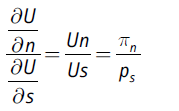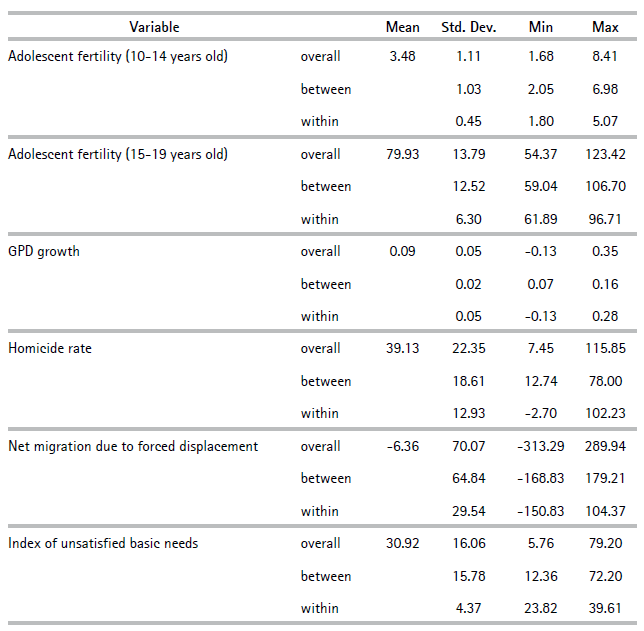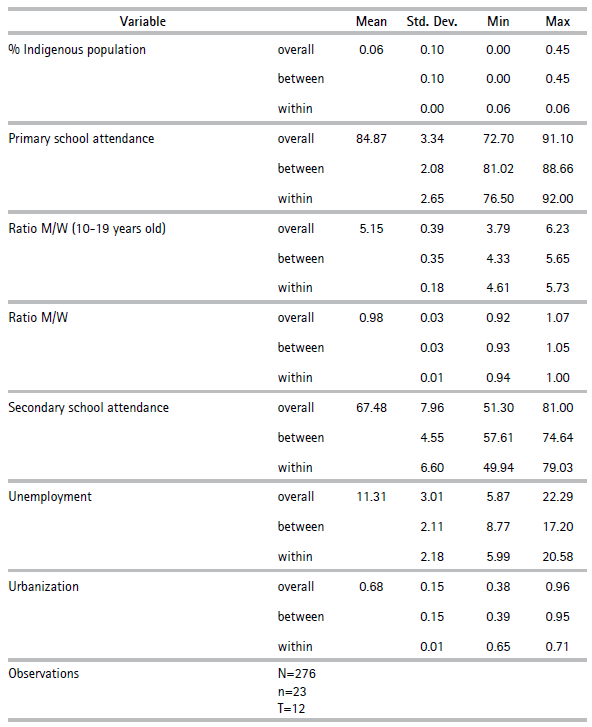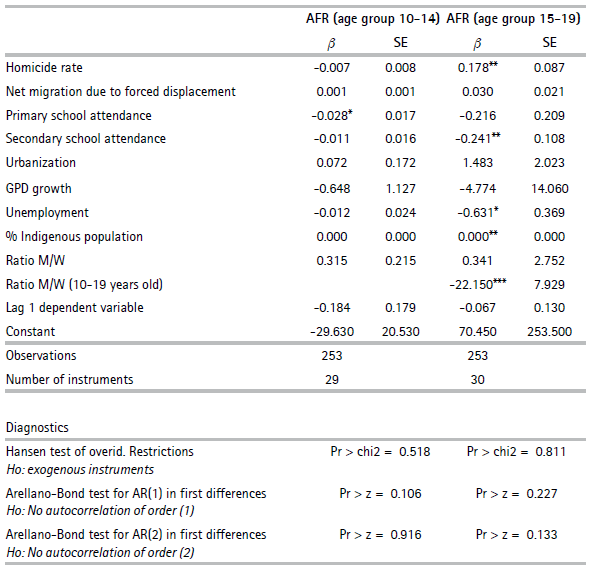1. Introduction
Both violent crime and fertility are important issues in many developing countries. Urban crime destabilizes citizen security and disrupts any degree of normality in public and private life. In this respect, crime brings both social and economic costs. It discourages economic growth as a violent environment makes it very difficult to secure property rights, and investments in human capital become risky, preventing agents from investing in their own training. At the same time, fertility plays an essential role in explaining demographic transitions, education, and economic growth.
This paper identifies at least two different schemes through which economists have explored the relationship between crime and fertility. The first and the most influential work is by Donohue and Levitt (2001), and argues that the legalization of abortion granted by the United States Supreme Court in 1973 played an important role in reducing crime rates in 1990. This link relies on two premises: 1) The legalization of abortion influences crime 15-20 years later, when the cohorts born after the entry into force of liberalized abortion would start reaching an age of high vulnerability and exposure to crime. In other words, when a cohort reaches the age at which it is more likely to commit a crime (between 18 and 24 years of age), there will be fewer young males in the high crime rate age bracket. 2) Legalized abortion means that women can optimize their timing of childbearing. A child born before legalization is more prone to be unwanted than a child born after legalization. This analysis suggests a causal relationship running from fertility to crime.
In the second scheme, Huang et al. (2015) reverse this hypothesis by testing the impact of crime on childbearing. They evaluate the hypothesis that criminal men are less desired in the marriage market as their economic status and employment stability are lower than those of non-criminals. Thus, they suggest that crime can change marriage patterns, leading to a reduction in fertility rates.
This work follows the literature intended to assess the causal impact of violent crime on adolescent fertility. However, unlike Huang et al. (2015), this paper claims that such an impact might be positive and explores other transmission channels to account for that impact. The authors here argue that crime shortens life expectancy, thereby leading to faster transitions in life-course and therefore, the decision of bearing children is made earlier (Redelings et al., 2010; Wilson and Daly, 1997).
As far as can be determined without further research, the only scholar who has suggested a causal direction running from crime to fertility, for the Colombian case, is Salazar (2014). For him, there is a possible correlation of crime on demographic control in the city of Cali, Colombia. Furthermore, Salazar (2016) claims that the risk of dying from a crime leads teenagers to opt for a risky life-course. Consequently, teenagers have children as soon as possible, producing a strange mechanism of population growth. Nonetheless, this hypothesis, although persuasive, remains empirically untested, and this paper contributes to alleviating this problem.
We use panel data methods to test the leading hypothesis of this work, namely that crime has a direct effect on adolescent fertility. We model the adolescent fertility rate (AFR) for the 10-14 years and 15-19 years age groups separately, and use a panel data set for Colombia at departmental level from 2003 to 2014. We use department fixed effects and an Arellano-Bond estimator, in which the homicide rate is defined as an endogenous variable.
Our findings suggest that violence contributes to increasing adolescent fertility rates in Colombia by fostering forced displacement and depriving communities of access to reliable information and health services. In this respect, this analysis is innovative in the exploration of a dimension that has been traditionally neglected in the research on fertility and crime. The purpose of this analysis is to contribute in some way to the understanding of urban crime and fertility choices in Colombia and to a useful public debate about the need to strengthen the country’s institutions.
The remainder of this paper is organized as follows. Section 2 lays the theoretical framework for households’ fertility decisions and discusses the alternative hypothesis about the impact of crime on fertility. Section 3 presents the empirical strategy and Section 4 presents the results. Finally, some conclusions are drawn in Section 5.
2. Fertility, Life Expectancy, and Crime
South and Messner (2000) put forward the hypothesis that crime has a negative impact on childbearing. High rates of homicides and imprisonment decrease the number of available eligible males to marry and criminal men are less desired in the marriage market as their economic status and employment stability are lower than those of non-criminals. This deficit of available eligible males and the fact that they are less desirable end up reducing the number of marriages, leading, in turn, to a lower fertility rate.
Huang et al. (2015) empirically test this hypothesis. They evaluate the possible effects of crime on fertility rates by using a panel data for 20 counties and cities in Taiwan for the 2000-2010 period. They find that crime has a negative impact on fertility; however, the magnitude is modest. Besides, when explaining the family’s decision to have children, the main determinants include economic factors such as disposable income, household savings, unemployment, and female ratio.
In opposition to this hypothesis, another type of preference with respect to criminals and their desirability in the marriage market is conceivable. Neighborhoods with the highest prevalence of violence are also the poorest. Not surprisingly, in such a social environment, offenders are seen as having a better status than that of non-criminals. This would make criminals highly successful in the love market, leading to higher fertility (as casual evidence, in Colombia it is common to see that offenders have multiple women at once). In this respect, this work focuses on an alternative hypothesis which is introduced below.
Crime shortens life expectancy, which in turn, changes time preference. Individuals therefore make earlier decisions about their life transitions, especially in terms of having children, and thus, crime can act as a motivating factor for fertility. Several works in both economics and psychology support this hypothesis.
The concept of time preference has been widely used among psychologists. This tendency is called a short time horizon, impatience, myopia, or lack of self-control. It describes a behavior that allocates less value on the future but more on the present. For instance, people addicted to drugs attribute a higher weight to their present consumption than their future consumption. This idea is also familiar to economists who are used to thinking in terms of the marginal rate of substitution between current and future utility (Uzawa, 1968) or in terms of, for example, the rate of time preferences and discount factor (Becker and Mulligan, 1997), which varies from person to person according to their willingness to wait.
For the case of pregnancy, some scholars claim that teenagers have a high time-preference for the present. Therefore, when facing fertility choices, current factors weigh heavily within the decision-making process (Leibowitz et al., 1986). Following this same line of thought, Chesson et al. (2006) examine the relationship between sexual behavior and individual discount rates for teenagers and young adults. According to their findings, higher discount rates are significantly associated with some kinds of sexual behavior, such as having sex before the age 16 years, sexually transmitted diseases, and pregnancy status. Adolescents discount their future more heavily and are, therefore, not able to appreciate the full long-term consequences of risky sexual behaviors.
Colen, Ramey and Browning (2016) explore a line of thought about the relationship between crime and adolescent fertility. They identify four factors that explain the decline in crime and teen childbearing in the United States from the 1990 - 2010 period by using simultaneous fixed effects regressions. In the United States, both rates of violent crime and births to women aged 15-19 have been steadily decreasing over the previous 25 years. The apparent occurrence of both declines leads authors to think that changes in economic opportunities, demographic shifts in population composition, state-level policy, and expectations of health and wellbeing are the most important factors that jointly explain the decline in both crime and teen childbearing.
In the same line, Herckman and Dimitry (2007) indicate that family is a major producer of the skills and motivation required for producing successful students and workers. Hence, adverse environments5 place children at risk of social and economic failure. They also point out that there is substantial evidence that children who are born in adverse environments are more likely to commit a crime and have a teenage pregnancy.
When accounting for factors such as poverty, health, income, economic growth, addictions, and mortality, many economic models endogenize the discount factor. For instance, in a pioneer work, Becker and Mulligan (1997) point out that lower mortality and greater health rates affect time preference by inducing individuals to place more weight on the utility of future periods. Similarly, Chao et al. (2009) test that health and survival probability are crucial determinants of time preference in South Africa and in Durban. In this same line, Shavit et al. (2013) compare the time preferences of soldiers in the Israel Defense Force (IDF) with those of university and high school students by using experimental designs. They find that soldiers have a higher discount rate compared to similar age groups. For them, this outcome is owed to a high-perceived risk in the army or a higher mortality risk, which, in turn, produces a high preference for the present, concluding that violent environments affect time preference.
Empirical evidence then shows that certain groups of the population, such as teenagers and young adults, tend to discount their future heavily, which ends up affecting their sexual behaviors, namely their pregnancy status. Likewise, time preference can vary in accordance with an uncertain future, a high mortality, or a violent environment as in the case of soldiers. Hence, it can be argued that under a risky situation or a violent context life expectancy will tend to be shorter, leading agents to modify their time preference by assigning more value on imminent goods than future goods. It can alter life-course decisions and, especially, childbearing choices. It would be particularly strong for the case of teenagers who seem to have an inclination to discount their future relatively steeply in comparison with adults. Some additional evidence appears to be in line with this hypothesis.
Wilson and Daly (1997) observe that women tend to reproduce in earlier ages when life expectancy decreases across neighborhoods in Chicago. For example, in neighborhoods with low life expectancy, the median age of women giving birth was 22.6 years old. In contrast, in neighborhoods with high life expectancy it was 27.3 years old. Thus, the authors conclude that life expectancy affects the median age for giving birth. These results then suggest that life expectancy is a psychological determinant when making individual decisions on life-course. The authors also suggest that people behave as if they adjusted their time preference and risk acceptance in relation to their life expectancy.
Thus, low life expectancy generates a compressed time horizon, which encourages earlier decisions on having children, thereby increasing adolescent fertility.
2.1. Economic theory of fertility
The standard microeconomic theory of fertility resorts to rational economic behavior in explaining family size. The demand for children proposed by Becker (1960), defined as the number of children desired when there are no obstacles to the production or prevention of children, is the key for understanding fertility behavior. Becker highlights that often the effective birth control methods are seen as one of the major determinants of decline in fertility. However, he argues that it is not the real cause of a decreasing demand for children as the birth control methods are simply the agents’ induced response, when facing a set of incentives.
Hence, in the traditional microeconomic theory, an individual spends her given income to maximize her utility U of goods or services subject to her budget constraint. In this context, by assuming that each family maximizes a function of the quantity of children denoted by n and the quantity of other commodities represented by s, then the utility function of each family can be written as:
Families produce offspring by consuming market goods and services and employing part of their time, especially the time spent by the mother in bearing and raising children. Thus, the budget constraint that a family faces is the following:
Where the costs or the shadow prices of n and s are denoted by ps and πn and / is the total income. The budget constraint and the marginal utility conditions determine the optimal quantities of n and s as follows:
To simplify this, the price of other commodities is taken as the numerarie ps = 1; thus, demand for children is similar to a standard demand function:
This economic approach then suggests that the demand for children depends on the relative price of children and total income. As consumer theory states, the income and substitution effects also characterize the demand function for children.
However, this first approach presents two drawbacks. First, the inconsistency between the evidence and theory on whether children are considered normal goods. Contrary to the assumption made about the sign of the income effect, empirical evidence demonstrates that fertility rate decreased over the last centuries as income rose. Second, the analysis of the demand for children might consider them as inferior goods, i.e., the demand decreases when income rises. It implies that an agent substitutes a low-quality good with another that is more costly, and which provides her with more pleasure.
As a way to address these shortcomings, Becker and Lewis (1973) add the trade-off between quality and quantity of children to explain family size. The quality dimension refers to the amount of resources that parents provide for their children in terms of nutrition, health, leisure, and education. By introducing this dimension, the authors demonstrate that the quality-quantity interaction is the most important reason for the effective price of children to rise with income. Thus, the new utility that one family maximizes is denoted by
As in Equation (1), n is the number of children; s represents the quantity of other commodities, and . means the expenditure on each child (on their quality). Thus, the new budget constraint would be:
Where pc means the market price of goods, and ps refers to the price of goods consumed by parents; c represents child-service and therefore, pcc is the total amount of expenditures on each child.
Another important implication derived from quantity-quality trade-off is related to income elasticity. The economic theory explains that a change in price of any good moves in the opposite direction to the demand for that good and for substitute goods (Becker, 1993). Therefore, the quality-quantity interaction is highly responsive to shadow price and income. An increase in income raises the quality of children, which, in turns, increases the shadow price of quantity, thereby generating a negative relationship between income and fertility.
2.2. A model of fertility choice under a violent environment
This section illustrates the effect of crime on fertility theoretically. Sadly, an exhaustive literature review did not reveal any theoretical frameworks intended to formalize the relationship between these two variables, in the way suggested by the hypothesis held in this work. Notwithstanding, this paper proposes a reinterpretation of the time preference model advanced by Becker and Mulligan (1997). Before undertaking such a reinterpretation, it seems appropriate to make a precision regarding the sense of the hypothesis defended by this paper. Becker (1993) discusses the idea of how uncertainty may affect fertility choices. In his own words:
“In a high mortality environment, the portfolio of assets that elderly parents can rely on when they are in need is much less diversified when parents invest a lot of human capital in only one or two children than little human capital in many children. For the death of a child with much human capital destroys much of insurance protection. However, after mortality has declined to much lower levels, the diversifying advantages from large families are greatly reduced because the variability in length of life also is much lower. This provides another reason why declines in youth and adult mortality reduce the demand for large families and raise the human capital invested in each child” (p.194).
Thus, Becker (1993) suggests that there is a link between fertility and mortality in a causal direction running from mortality to fertility. Nonetheless, it is possible to identify two lines of thought in which uncertainty generated by a high mortality environment affects fertility decisions. The first is intended to show how mortality rates in children and adults induce fertility changes, which appears to be the line suggested by Becker in the quotation above. Meanwhile, a second line explores how potential-parent mortality can prove to be a motivating factor of fertility. The latter is the sense of the hypothesis held in this paper.
Notice that the evaluation of the impact of adult mortality on childbearing has often been neglected, especially when adult mortality results from violent crime. In an attempt to partially fill this gap, this paper provides a first approach from a theoretical perspective by reinterpreting the model built by Becker and Mulligan (1997). A more rigorous approach demands further research and, hence, the formalization of a model with the characteristics outlined in this paper remains a challenge.
We follow Becker and Mulligan (1997) about time preferences, although in the context of this paper, homicide rates are seen as the principal factor of mortality. The model states that individuals make earlier decisions about fertility, when their time preference changes in response to the probability of death. Crime shortens time horizons and people shift their time preferences, thereby allocating greater weight on present utilities than future ones.
The model suggests that an individual6 values her future based on her effort to imagine future periods. Thus, considering the first period for a consumer that lives two periods:
Where f0(·) and f1(·) represent the map functions of consumption level for the present and the future respectively. In this paper, children are seen as a good that yields utility to parents and, therefore, are arguments of f0(·) and f1(·). The discount factor is denoted by β, and it adjusts in accordance with the dimension of future gratification. Furthermore, β < 1 due to an imperfect ability to imagine the future.
The level of effort and time spent imagining and appreciating the future is denoted by S. Furthermore, this model assumes that the effort and time spent anticipating the future (S) cannot be invested in producing, neither at home nor in the market. However, S may be impacted by expenditures on certain goods and activities. In this regard, Becker and Mulligan (1997) point out the following:
“Purchases of particular goods, such as newspapers, can distract one’s attention away from current pleasures and toward future ones. A person may spend additional time with his aging parents in order to better appreciate the need for providing for his own old age [...]. Schooling also determines S partly through the study of history and other subjects, for schooling focuses student’s attention on the future” (p. 736).
The authors explain that more resources spent on imagination enhance the visualization of future pleasures:
Moreover, the authors expand the model by assuming that consumers live for more than two periods. Then, the consumer maximizes,
Where T is the length of life and fi is assumed to be non-negative, strictly increasing, and strictly concave for non-negative consumptions. Some Inada conditions are imposed to guarantee the interiority of solutions. Thus, the intertemporal budget constraint is:
The present value of all assets and earnings is denoted by A0 (also, capital market is assumed to be perfect), the interest rate factor is represented by Ri, and π is the price of S. Notice that S can be interpreted as a future-oriented capital. Such a capital does not depreciate over time. The model assumes that π is the same for every individual and equal to 1. Applying the first order conditions, gives / as the marginal utility of consumption at any age . When adjusted by a discount factor and an interest rate factor, this marginal utility must equal the marginal utility of wealth,λ0:
Equation (11) shows that the marginal benefit of S depends on the rate at which S increases the propinquity of future utilities(β0 (S)), the length of life (T), and the levels of the discount rate and the future utilities:  The effect of future utilities can be fully appreciated in the two-period case (T = 1):
The effect of future utilities can be fully appreciated in the two-period case (T = 1):
By analyzing (11) and (12), Becker and Mulligan (1997) conclude that:
“An increase in future utilities raises the advantages of low discounts on the future since discount rates are then weighted by larger utilities. In essence, there is a complementarity between future utilities and weighting the future more heavily. Consequently, anything that raises future utilities without raising the marginal utility of current consumption will tend to lower the equilibrium discount on the future.” (p.738-739)
The authors also suppose a case in which life expectancy increases from T to T0. In our case, we assume that such an increase is due to a reduction in crime, and that it is coupled with a rise in lifetime earnings that keeps the marginal utility of wealth constant λ0. If the discount rate remains unchanged, consumption in the first . years also remains unaltered. However, consumption between T and T0 would be positive. According to Equation (12), this increases the marginal benefit from investments in time preference, and therefore raises the equilibrium accumulation of future-oriented capital. In the author’s words, “longer lifetimes not only directly induce consumers to plan further into the future, but lower mortality also induces them to place more weight on the utility in all future periods” (p.738).
Again, in the context of the relationship between crime and fertility, this model would suggest that crime shortens life expectancy and hence prevents people from spending time and effort on imagining future pleasures, leading them to assign more weight on the present utility. That is, the probability of death affects the productivity of imagination and the discount factor. This theoretical hypothesis, obtained from the model in Becker and Mulligan (1997), seems to fit with the causal evidence from Colombia7.
These types of interactions between crime and fertility should be analyzed in models that can explicitly accommodate terms for fertility choices and the effects of crime on time preference. Although, the reinterpretation provided here is not enough to account for these phenomena, at least it seems to go in the right direction.
3. Empirical strategy
The World Health Organization defines Adolescents as individuals in the 10-19 years age bracket, although Adolescent fertility rate is usually computed as the number of births per 1000 women aged between 15 and 19 years. A 2013 report published by Colombia’s Health Ministry (2013) points out the increasing birth rates among women under 15 years of age. To account for this, in this paper, we additionally compute the adolescent fertility rate between the ages of 10 to 14 years and analyze it separately from the usual rate.
We conduct a panel data analysis under different specifications. The first specification defines the relationship between adolescents’ fertility decisions and crime in Colombia as a fixed effects model represented in the following equation:
Where AFRit represents the Adolescent Fertility Rate for department i in year t, where j = 10-14 years, 15-19 years. The independent variable is the annual homicide rate hit, defined as the number of homicides per 100.000 inhabitants, which is a good proxy for the persistence of violent crime in Colombia. SEit is a vector of socio-economic control variables, β is the vector of estimated parameters, αi is the department fixed effects, and uit is the idiosyncratic error term.
We favor fixed effects over random effects because the database we use corresponds to a population and not to a random sample. Thus, the fixed effects model allows us to control for unobservable individual characteristics, under the assumption that these do not change over time and are correlated with the explanatory variables.
In opposition to the hypothesis of this article, one could argue that fertility is a motivating factor of crime, which would generate a problem of simultaneity or reverse causality. Gaviria et al. (2010) argue in this respect that fertility can influence crime only in the long term, in particular, once the children of these adolescents have reached an age where they can commit a crime.
To completely rule out the possibility of a reverse causality between crime and fertility, we estimate the following dynamic model, by using the Arellano-Bond estimator:
In this model, AFR j it -1 is the first lag of the dependent variable and hit, the annual homicide rate is defined as an endogenous variable.
This estimator makes it possible to treat explanatory variables, such as the homicide rate, as potentially endogenous providing further insight into the inverse causality between AFR and crime. Furthermore, the presence of the lagged dependent variable helps us determine the importance of past AFR on present trends.
3.1. Data
The data used in this article comes from different sources, mainly from the National Administrative Department of Statistics (DANE) and the Directorate of Criminal Investigation and Interpol (DIJIN). We have a sample for 23 out of 32 Colombian departments: Antioquia, Atlántico, Bolívar, Boyacá, Córdoba, Caldas, Caquetá, Cesar, Chocó, Cúcuta, Cundinamarca, Guajira, Huila, Quindío, Magdalena, Meta, Risaralda, Nariño, Norte de Santander, Santander, Sucre, Tolima, and Valle. These departments were chosen based on data availability for the 2003 – 2014 period. The dataset is a balanced micro panel (n > T) with 276 observations (N) for 23 departments (n) and a period of 12 years (T).
The adolescent fertility rates (age groups 10-14 years and 15-19 years) are computed using the demographic statistics published by DANE. The homicide rate (HR) was collected from DIJIN statistics. Additionally, we include nine explanatory variables of socio-economic and contextual order that, according to the literature, are determinants of fertility (e.g., Flórez, 2010).
The economic variables included in this work are annual percentage of GDP growth and the unemployment rate. Most of the empirical evidence acknowledges that the association between fertility and economic growth is strong. We expect an increase in economic growth to reduce the adolescent fertility rate and for higher unemployment to be positively associated with female fertility decisions. Unemployment may reduce the cost of having children since women have additional time to raise their children (Andersen and Ozcan, 2011). On the other hand, the disposable income is lower when households face unemployment, which could delay fertility decisions. Thus, this relationship can be either positive or negative (Rocha and Fuster, 2006).
We include primary and secondary school attendance to account for the level of human capital in adolescents, an index of favorable conditions for development. According to Barro and Becker (1989), education and fertility are negatively correlated; families with higher human capital prefer to have fewer children in order to invest more in the education of each child. More recently, Lochner (2004) has pointed out that violent and property crime rates tend to rise during adolescence and decrease afterwards. In his study, Lochner shows that education has a significant causal (negative) impact on men’s subsequent criminal activity, as measured by self-reports, arrests, and incarceration. He concludes that education and training increase human capital levels and market wages, raising the costs of planning and participation in crime.
Primary school attendance is a good proxy for the proportion of non-illiterate women. Secondary school attendance provides greater access to information on methods of birth control. In addition, to a certain degree, attending secondary education marks the moment when women begin to exercise their autonomy, and form their expectations about plans for the future. In sum, we expect for both primary and secondary education to contribute to delayed fertility decisions. Much of the literature states that children who are born in disadvantaged homes are less educated and more prone to commit social pathologies, including crime and having children in early ages (Herckman and Dimitry, 2007).
The contextual variables include the level of urbanization, the indigenous population in the department, the net migration of people displaced by violence, the ratio of men to women and the ratio of men to adolescent women (10-19 years).
The urban population accounts for the availability and access to information on responsible sexual practices, education and health services. According to Flórez (2010), the adolescent fertility rate tends to be lower in urban areas, with respect to rural areas, thanks to better access to the aforementioned services and information.
Information about the indigenous population and migration due to violence capture societal elements affecting fertility decisions that are specific to these contexts. The indigenous population was included for two reasons. First, because demographic statistics suggest that the overall fertility rate is higher in ethnic populations, meaning that the adolescent fertility rate among these communities may also be higher. Second, the indigenous and Afro-descendant communities have been repeatedly affected by the internal conflict, which implies, among other things, greater socioeconomic difficulties.
The migration of people displaced by violence measures the net flow of individuals (difference between immigration into and emigration from the department due to the violent conflict) during the year by 10.000 inhabitants. The displaced families usually face economic difficulties, at least in the short term. Therefore, a greater share of the population under these conditions can be positively related with the adolescent fertility rate, since, as mentioned above, financial capacity has an inverse effect on fertility decisions8. Furthermore, forced migration is a direct consequence of crime and violence in Colombia, the inclusion of this variable in the model can provide us with further insight into the mechanisms by which crime may impact the AFR (see Figure 4).
We also expect a direct relationship between adolescent fertility rate and the men to women (adolescent women) ratio. A lower number of men per every woman (adolescent woman) is related to a lower rate of fertility (Huang et al., 2015).
3.2. Patterns of Fertility and Crime in Colombia
During the second half of the 20th century, Colombia experienced an important demographic change. The female fertility rate fell from 6.7 children per woman in 1969 to 3.3 in 1986 and 2.6 in 2000 (Flórez, 2005). Figure 1 shows the evolution of Total Fertility Rate (TFR) and the Adolescent Fertility Rate (AFR) for women aged 15-19 years, with a steady decline of the TFR during the whole period. Meanwhile, despite decreasing overall the AFR exhibits greater fluctuations and oscillates in the same high levels. For instance, it remained almost constant from 2003 to 2009, while it grew significantly during the 2010-2012 period.
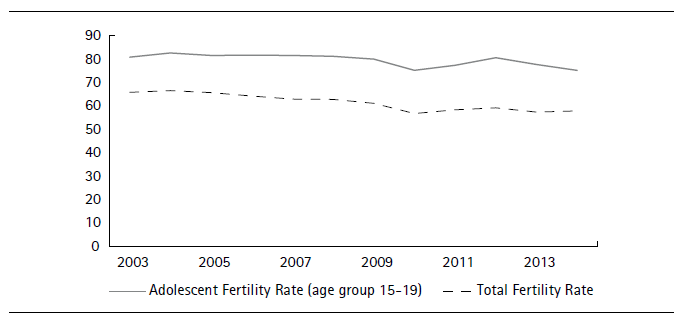
Source: Authors based on demographic statistics from DANE.
Figure 1 Adolescent Fertility rate and homicide rate trends in Colombia, 2003-2014
Recently in Colombia there have been two periods of high levels of violent crime. The first goes from the 1980s to the year 1991; this period corresponds to an increase in drug trafficking and the consolidation of the Medellin and Cali cartels. The second, from 1997 to 2002, coincides with the reinforcement of illegal armed groups such as Paramilitaries, ELN, and FARC (Sánchez et al., 2003). Despite the decrease in the homicide rate during the last decade, rates for Colombia remain among the highest in the world and are the second in Latin America after Venezuela’s. Figure 2 shows the evolution of the homicide rate in Colombia from 1998 to 2014.
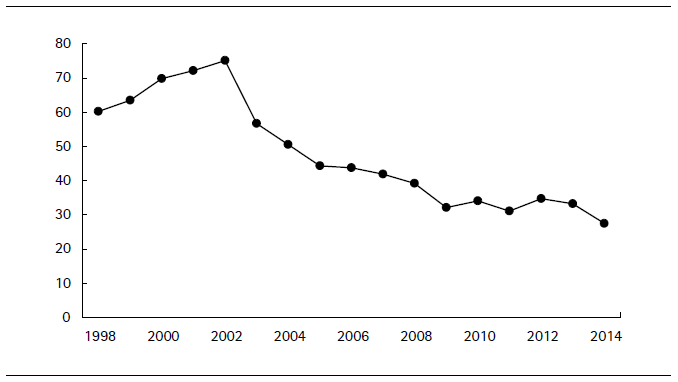
Source: Authors based on DJIN data and Chaparro-Narváez et al., 2016 (for homicide rate from 1998 to 2002).
Figure 2 Homicide rate trend in Colombia, 1998-2014
Figure 3 presents Adolescent Fertility Rate (AFR) for women in the 10-14 and 15-19 years age groups and homicide rate trends in Colombia by Department, 2003-2014. According to a recent report by CNMH Colombia, violence in Colombia goes beyond simple criminal acts; it is a manifestation of fractures in the configuration of the regional political and social order. The analysis of the spatial dimension in the conflict in Colombia may shed some lights on the nature of the political and social problems that persist in the most violent areas.
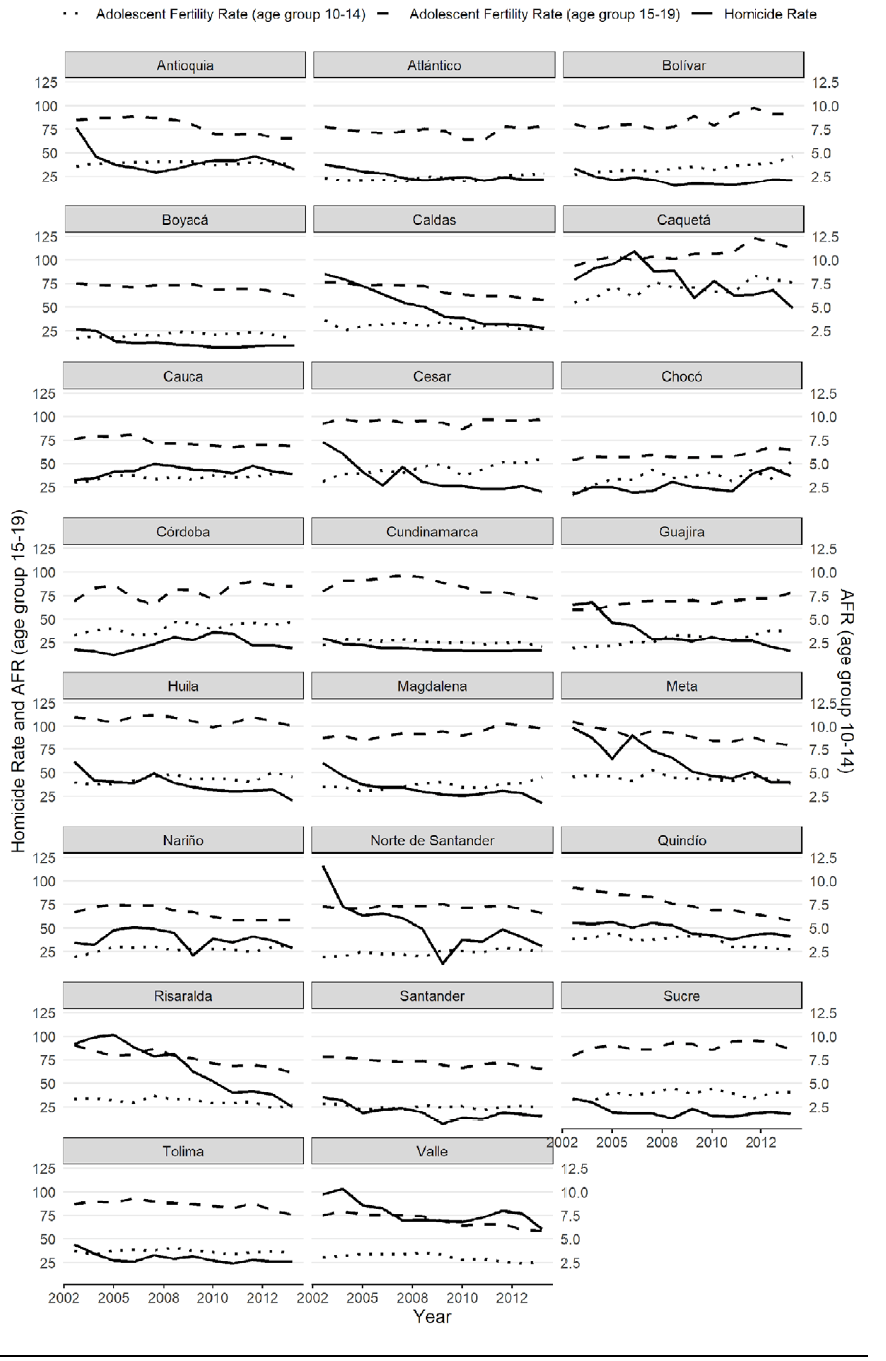
Source: Authors based on DIJIN and DANE data.
Figure 3 Adolescent Fertility rate and homicide rate trends in Colombia by department, 2003-2014Notes: The left axis corresponds to the adolescent fertility rate for the 10-14 age group and the right axis to the other variables. Adolescent Fertility represents the number of births per 1000 women. Homicide rate represents the number of homicides per 100.000 inhabitants.
In this figure, we see that AFR for the 10-14 age group remains considerably lower than the AFR for the 15-19 age group; nevertheless, all departments exhibit a constant or increasing rate. On the other hand, AFR for the 15-19 age group and homicide rates follow a decreasing trend during the period, for most of the departments.
Table 1 presents the descriptive statistics of the main variables in our sample.
Table 1 Descriptive Statistics
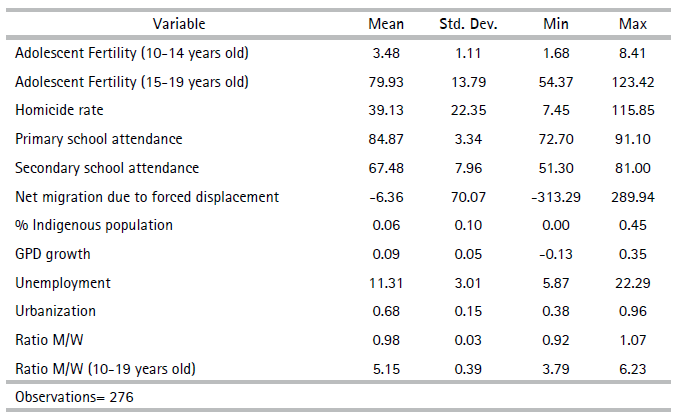
Note:Full table including within and between variance in Annex A.
Source: Authors based on DIJIN and DANE data.
On average, there are 3.48 births for every 1000 women between the ages 10-14. In the 15-19 age group, there are on average 79.93 births per 1000 women. In 2012, the Caquetá department reached the highest number of births (in this sample) in both age groups with 8.41 and 123.42, respectively. The lowest number of births (in this sample) were registered in Boyacá in 2014, with 1.68 births in the 10-14 age group and Chocó in 2003, with 54.37 births in the 15-19 age group.
On average, the homicide rate is 39.13 homicides per 100.000 inhabitants. The highest homicide rate was registered by the Norte de Santander department, with 115 homicides per 100.000 inhabitants in 2003. The lowest figure was reached in the Santander department in 2009 with 7.45. Finally, on average, the net migration due to forced displacement is -6.36 individuals per 10.000 inhabitants. The department with the highest population outflow in 2006 was Caquetá, with a net migration of -313.29 per 10.000 inhabitants. The department with the highest inflow of individuals is Cundinamarca, which received 289.94 individuals per 10.000 inhabitants in 2007. Figure 4 shows that, not surprisingly, departments with the highest homicide rates also exhibit the highest outflow of individuals. Furthermore, some of those departments also show higher AFR.
4. Empirical Results
Table 2 presents the estimation output of the department fixed effects panel model.
Table 2 Adolescent Fertility, fixed effect model
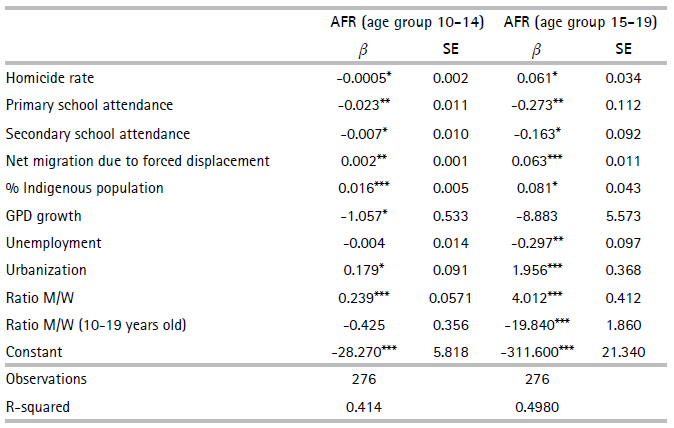
Note:We performed the test for heteroscedasticity, serial correlation and cross-section correlation. The model for AFR for the 10 - 14 year age range was estimated using robust standard errors to correct for heteroscedasticity. The model for AFR for the 15 - 19 year age range was estimated using Driscoll-Kraay standard errors to correct for heteroscedasticity, serial correlation and cross-section correlation. * p<0.10, ** p<0.05, *** p<0.01
Source: Authors based on DIJIN and DANE data.
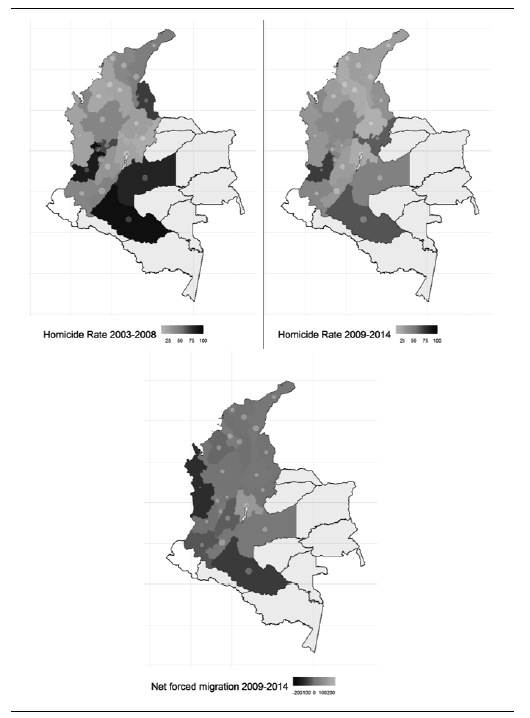
Source: Authors based on DIJIN and DANE data.
Figure 4 Homicide rate and net forced migration and Adolescent Fertility Rate 2003-2014Notes: The white circles represent the AFR for the 15-19 age group, the size is proportional to the magnitudes of the index. The white area corresponds to missing data.
The results of this model show a positive and significant relationship at 10% between the homicide rate and the AFR for the 15-19 age group, supporting the hypothesis of this work. It suggests that AFR for the 15-19 age group increases by 61 births per 1000 women when the total number of homicides increases by 1000 deaths per 100.000 inhabitants.
On the other hand, when it comes to the AFR for the 10-14 age group, the relationship with crime is negative and significant at 10%. This suggests that AFR for the 10-14 age group decreases by five births per 1000 women when the total number of homicides increases by 1000 deaths per 100.000 inhabitants. This is opposite to the hypothesis of this work, and may suggest that fertility decisions among the youngest adolescents are actually more premature in environments that are more peaceful. Women in the 10-14 age range may have different incentives or restrictions than their older counterparts.
The two variables for human capital index, primary and secondary school attendance, are significant at 5% and 10% for both age groups respectively, and have the expected sign. This result supports the hypothesis that adolescents’ level of human capital has a negative effect on adolescent fertility, which indicates that a greater proportion of girls receiving formal education contributes to reducing teenage pregnancy.
The net migration of displaced persons in each department seems to be correlated with AFR, with a positive and significant effect at 5% and 1% for both age groups respectively. In other words, for every new 1000 migrants, fleeing from a violent environment, AFR goes up by about 2 births per 1000 women in the 10-14 age range and about 63 births per 1000 young women in the 15-19 age range. Any migration always brings demographic transformations with it; in this case, the model suggests that the arrival of people in difficult contexts in a given department may contribute to increasing the AFR. Moreover, the presence of a larger indigenous population has a positive correlation with the fertility rate among the youngest women. As expected, fertility rates tend to be greater among these communities.
The GDP growth rate is significant at 10% and has the expected sign only for the 10-14 age group. This result is consistent with economic theory and suggests that adolescent fertility rates, especially among the youngest adolescents, decreases as income grows.
Contrary to what would be expected, an urbanized population presents a positive and significant effect on AFR. Theory suggests that AFR is lower among larger urban populations as a result of a greater supply of health and education services. However, our model suggests that AFR increases with urbanization levels, which may be explained by cultural factors. Furthermore, the men to women ratio have a direct relationship with our dependent variable as well. It indicates that a greater (lower) share of men in relation to women tends to increase the AFR. However, the ratio of men to women in the 10-19 age group has a negative relation with AFR, and it is significant only among those aged 15-19.
Table 3 presents the Arellano-Bond estimator of the model, in which the homicide rate is taken as endogenous. This model was originally specified in Equation (14) as dynamic, meaning that it includes a lag of the dependent variable, allowing us to explore potential long-run effects. However, the lag of the dependent variable was not significant for any age group, leading us to re-estimate the model without this term (output of the dynamic models are in annex B).
The diagnostics suggest that the homicide rate is not endogenous to the AFR for the 10-14 age group, meaning that the most appropriate model to describe these variables is the fixed effect model shown in Table 2. In contrast, the homicide rate is endogenous to the AFR for the 15-19 age group.
The results of this model show a positive and significant relationship at 10% between the homicide rate and the AFR for the 15-19 age group, once again supporting the hypothesis of this work. Once the endogeneity of the homicide rate is controlled, the output suggests that the AFR for the 15-19 age group increases by 213 births per 1000 women when the total number of homicides increases by 1000 deaths per 100.000 inhabitants. This effect is 3.5 times higher than the one suggested by the fixed effect model.
In this model, the only factor significant at 1% and which has an expected sign is secondary school attendance. An increase of 10% in the proportion of secondary school attendance may reduce the AFR by 2.7 births per 1000 women. According to Mesa Salamanca and Junca Rodríguez (2011), secondary education tends to reduce fertility because women have greater access to information about contraceptive methods. Moreover, high school can alter values in adolescents, life expectancy, and the status of women. For instance, women with less education may limit their expectations and may see motherhood as a primary source of identity (Hayford, 2009).
Table 3 Adolescent fertility, dynamic panel-data estimation, no lag dependent variable
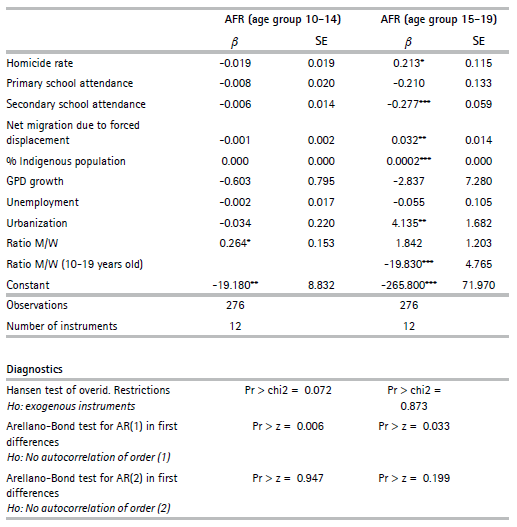
Note:Endogenous variables: Homicide rate. Both models use robust standard errors.* p<0.10, ** p<0.05, *** p<0.01.
Source: Authors based on DIJIN and DANE data.
The net migration of displaced persons in each department exhibits a positive relationship with AFR, with a significant effect at 5%. Moreover, the presence of a larger indigenous population has a positive and significant correlation with fertility rates among the youngest women, although small. As expected, fertility rates tend to be greater among these communities.
Contrary to what would be expected, an urbanized population presents a positive and significant effect on AFR. Finally, the ratio of men to women aged 10-19 has a negative relationship with AFR and is significant only among those aged 15-19.
5. Conclusion
The purpose of this paper is to evaluate the effect of violent crime on adolescent fertility in Colombia, suggesting that the potential association of these variables is positive. In environments of high adult mortality, people tend to make earlier decisions about life transitions, especially in terms of child bearing. In this respect, crime is seen as a motivating factor. We test the leading hypothesis of this work, by using panel data methods for Colombian departments between 2004 and 2014. We model the adolescent fertility rate (AFR) for the 10-14 and 15-19 year age groups separately, and use a department fixed effects estimator and an Arellano-Bond estimator, in which the homicide rate is an endogenous variable.
The models seem to provide empirical evidence that, to some extent, supports the hypothesis that the homicide rate has a positive effect on adolescent fertility for the 15-19 age group; however, this result is statistically significant at 10%. Once the endogeneity of the homicide rate is controlled, the output suggests that the AFR for the 15-19 age group increases by 213 births per 1000 women when the total number of homicides increases by 1000 deaths per 100.000 inhabitants.
On the other hand, our model suggests a negative relationship between the AFR for the 10-14 age group and crime, also significant at 10%. It suggests that AFR for the 10-14 age group decreases by 5 births per 1000 women when the total number of homicides increases by 1000 deaths per 100.000 inhabitants. This result, opposite to the hypothesis of this work, suggests that the fertility decisions among the youngest adolescents are actually more premature in more peaceful environments. This implies that women aged 10-14 may have different incentives or restrictions than their older counterparts.
Other factors that may boost adolescent fertility rates are the net migration resulting from the internally displaced population and a larger share of indigenous communities in a given department. These results appear to provide further evidence in favor of our leading hypothesis. Forced displacement is a direct consequence of the conflict. Displaced families seeking refuge in departments with lower levels of violence usually face financial difficulties and lack access to education and health services, all of which contribute to increasing fertility rates in less violent areas. Indigenous communities are among those who have suffered and endured most of the consequences of the conflict. On the other hand, the model seems to support that adolescent fertility decisions can be postponed through increasing human capital and greater income.
The results of this paper contribute to explaining the connection between crime and fertility choices in Colombia by providing further insight into the different factors affecting adolescent fertility decisions. They make it possible to stimulate a useful public debate about the need to strengthen the country’s institutions and to ensure access to quality education, promoting early interventions programs, information about family planning and birth control.
It is important to highlight that, although crime can alter the perception of risk, there are multiple factors that explain adolescent fertility decisions, such as unprotected and indiscriminate sex, social acceptance of pre-conjugal sex, and intense eroticization of the culture promoted by the mass media, among other aspects. The absence of a clearly established causal link is a limitation of the present work. The clarification of channel transmission requires psychological and psycho-sociological research, using qualitative methodological strategies, case studies, ethnographic research, etc., that go beyond the limits of this first work.
By using an aggregate database, in this case by department, the results obtained could be capturing other phenomena related to unobservable variables, wrongly interpreting the estimated coefficient. For instance, the availability and access to information on responsible sexual practices, education and health services, represented in our model by the urbanization level, have a positive impact on AFR, which goes against theoretical predictions. To obtain better empirical approximations, following studies should work with databases that cover at least the municipal level or, in better scenarios, the neighborhood level or micro-data on apprehension.















